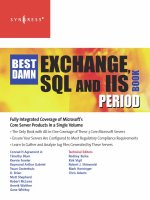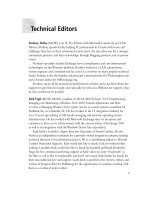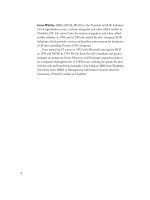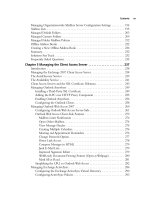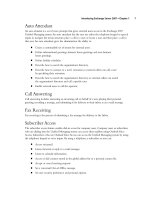Exxhange SQL And IIS- P21 doc
Bạn đang xem bản rút gọn của tài liệu. Xem và tải ngay bản đầy đủ của tài liệu tại đây (462.77 KB, 5 trang )
Installing Exchange Server 2007 • Chapter 2 67
2. Click Start | Run, type CMD.exe and click OK.
3. Now change to the Exchange Bin folder by typing CD C:\Program Files\Microsoft\
Exchange Server\Bin and press Enter.
4. Type ExSetup.exe /mode:Install /roles:<roles to be installed> as shown in Figure 2.33
(where we add the Hub Transport server role to an existing Exchange 2007 server) and
press Enter.
Figure 2.33 Adding a Server Role Using Unattended Setup
The process of removing a role from an Exchange 2007 server is very similar to that of adding a
server role. To remove one or more roles from an existing Exchange 2007 server, do the following.
1. Log on to the respective server with an account that has Exchange Organization
Administrator rights.
2. Open the Control Panel.
3. Click Add or Remove Programs.
4. Select Microsoft Exchange Server 2007.
5. Click the Remove button.
6. In the Exchange Server 2007 Setup Wizard, click Next (see Figure 2.34).
68 Chapter 2 • Installing Exchange Server 2007
Figure 2.34 Exchange Server 2007 in Maintenance Mode
Installing Exchange Server 2007 • Chapter 2 69
8. Let the readiness check complete, then click Uninstall. When the Exchange Server 2007
Setup Wizard has uninstalled the respective server roles, click Finish.
To remove one or more roles using the CLI, you must again use ExSetup.exe by performing the
following steps:
1. Log on to the respective server using an account that has Exchange Organization
Administrator rights.
2. Click Start | Run, type CMD.exe and click OK.
7. Clear the check boxes for the roles you want to remove and click Next (see Figure 2.35).
Figure 2.35 Removing an Exchange 2007 Server Role
70 Chapter 2 • Installing Exchange Server 2007
Uninstalling Exchange Server 2007
There might be situations in which you want to completely remove an Exchange 2007 server from
your Exchange organization. This can be done using either the Exchange 2007 Installation Wizard or
Setup.com.
Uninstalling Exchange 2007 using the Installation Wizard is done the following way:
1. Log on to the respective server with an account that belongs to the Enterprise
Admins group.
2. Open the Control Panel.
3. Click Add or Remove Programs.
4. Select Microsoft Exchange Server 2007.
5. Click the Remove button.
Figure 2.36 Removing an Exchange 2007 Server Role Using Unattended Setup
3. Now change to the Exchange Bin folder by typing CD C:\Program Files\Microsoft\
Exchange Server\Bin and press Enter.
4. Type ExSetup.exe /mode:Uninstall /roles:<roles to be installed>, as shown in
Figure 2.36.
Installing Exchange Server 2007 • Chapter 2 71
6. Now clear the check box for each server role, including Management Tools, and click
Next.
7. When the Readiness check has completed, click Uninstall.
NOTE
To remove the Mailbox server role, you’ll need to make sure no mailboxes exist in
the Mailbox database(s) on the respective server. In addition, if you have any Public
Folder databases on the server, you’ll need to move any existing offl ine address
books to a Public Folder database on another server. Also, keep in mind that you
will need to manually delete any EDB and transaction log fi les after you have
uninstalled Exchange, because this is not done via the Exchange Server 2007 Setup
Wizard.
Uninstalling Exchange Server 2007 using the CLI can be done the following way:
1. Log on to the respective server using an account that belongs to the Enterprise Admins
group.
2. Click Start | Run, type CMD.exe and click OK.
3. Now change to the Exchange Bin folder by typing CD C:\Program Files\Microsoft\
Exchange Server\Bin and press Enter.
4. Type ExSetup.exe /mode:Uninstall.
Removing all server roles from an Exchange 2007 server will also remove any installation fi les
as well as the Exchange server object and all its child objects from the Active Directory forest.
